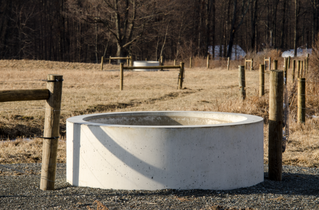CONSERVATION CORNER
A weekly blog for all things conservation
 By: Nathan Dewing, Agricultural Team Leader Bradford County farm fields are made for grass. Our grass covered hill fields can develop highly productive soil while contributing virtually no sediment to waterways; two reasons it is the primary crop for our food producers. Bradford county grass has been used to produce milk and meats for generations, and grazing can be one of the most efficient means of harvest. Water supply in grazing systems can make or break production efficiency, so let’s examine some of the key factors involved. The first, obvious consideration is source, which could be surface, spring, or well water. Clean water is very important, as chemical or biological abnormalities can cause health problems. Surface water from ponds or streams can be good sources, however accessing these while maintaining clean water takes a bit of planning. Limited access areas can be stabilized to help maintain clean water and livestock. Getting surface water into troughs at stabilized locations is preferred. Springs can be very cost-effective water sources and should be considered if flow remains strong enough during the driest parts of the year. Spring development is the term often used for capturing water from a spring source in order to divert some of the flow to a trough at a stabilized area. When the first two options are not feasible, then well water is used. Well water is usually clean and reliable but can be the costliest system to operate. There are solutions for all three whether or not electrical power is available.
Once the source is determined, attention can be turned to distribution. Consider two basic ways to think about the system – bringing livestock to water or water to livestock. You will find experienced producers with strong opinions on both sides of this debate. I have listened to both. One says cattle have four legs for a reason and on her operation, walk over a mile for water. Another says he wants water available every 300 feet. As a grazing system is planned, it will become apparent which approach fits best. I have helped manage both and offer this simplified comparison. Centralized water is simpler and less expensive to install and when managing pastures, may require establishing travel lanes for livestock. A highly distributed water system can be more complex and costly and can improve labor efficiency and livestock production. Distribution systems often combine buried and above ground water pipe. Winter-time water will require pipe buried below frost line, while pipe laid on top of the ground can provide economical and reliable supply when only needed during warmer months. There are many options for drinking troughs, portable and permanent, with options for electric or ground heat, and for all animal types. The conservation district and local partners help with water distribution planning and design to support grazing systems. A little planning goes a long way for the profitable use of Bradford County’s abundant grass crop. The Bradford County Conservation District is committed to helping people manage resources wisely. You can visit the Bradford County Conservation District at 200 Lake Rd in Wysox across from the Wysox Fire Hall. Contact us at (570) 485-3144 or visit our web page at www.bccdpa.com.
0 Comments
Leave a Reply. |
AuthorsVarious staff at the Bradford County Conservation District Archives
July 2024
Categories
All
|
|
Bradford County Conservation District
Stoll Natural Resource Center 200 Lake Road, Suite E | Towanda PA 18848 Phone: (570)-485-3144 |
